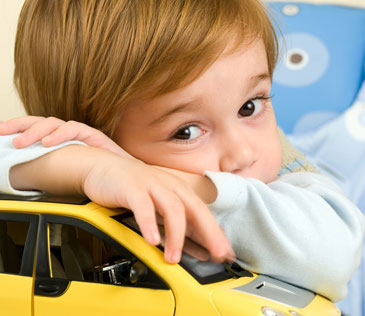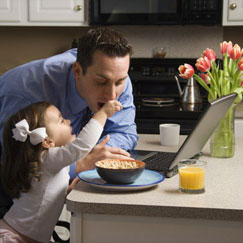Food allergies in children

Food allergies in children are not as common as it is believed and fortunately for parents they occur early. What do you need to know about them?
Little Elias, 3 years old, had just started eating his lunch, which included meat, vegetables and bread, when his mother noticed that he started scratching his mouth. After a while and after vomiting, his mother realized that she should probably go to the doctor, who diagnosed an allergy. He referred her to a specialist allergist, who diagnosed him with a food allergy and even wheat.
Gluten, which is found in many cereals (wheat, rye, oats, etc.), is a common allergen for children, along with milk, eggs, nuts, peanuts, seafood (such as shrimp). and soy. It is important for parents to recognize the symptoms of a food allergy in time so that they can change the child's diet and learn what to do if their child eats something "forbidden" to deal with the allergic reaction.
What means food allergy?
In case of food allergy, the body reacts as if the food consumed is bad. Thus, the immune system produces antibodies to fight the invader, the substance that causes the allergic reaction. The next time a person consumes the same food, the body secretes chemicals, including histamine, to protect itself. These substances cause allergic symptoms, which can affect the respiratory system, skin and cardiovascular system.
Thus, symptoms such as dry mouth, stinging on the tongue and pharynx, shortness of breath, rash, vomiting, cramps in the abdomen, diarrhea, low blood pressure and loss of consciousness (fainting) occur. The time period in which the symptoms occur varies from 2 minutes to 2 hours from the time the person came in contact with the allergen. In the most severe cases, a life-threatening condition called anaphylaxis can occur. It is important to clarify that food allergy and food intolerance, although they have the same symptoms, are different things, and this is because intolerance does not activate the immune system, it is unpleasant, but very rarely dangerous.
In general, most children eliminate allergies, especially when it comes to milk, eggs and wheat. Allergies to nuts and seafood are also common and are rarely treated.
Allergy's diagnosis
If your pediatrician suspects a food allergy, they may refer you to a specialist allergist, who will perform special tests (skin or blood tests) to determine if and in which foods your child is allergic.
After the diagnosis, the doctor will explain to you how to move. There is no cure for allergies, only abstinence from allergenic foods.
What does it mean?
Your child should avoid anything that is allergenic. Many people think this is simple, avoiding foods that cause allergies. But it's not that simple! Ordinary allergenic foods are found in a variety of products where our minds do not go. How do we understand it? From food labels.
Food companies are required by Greek law to list their ingredients and especially to indicate if they contain allergens, such as traces of milk, soy, eggs, nuts, etc.
7 advises for a menu against allergy
As stressful as it may sound for a parent, there is always a way to protect your child and not feel "excluded" from the various foods that others eat without fear. All you have to do is train the whole family to be prepared for any eventuality. From mom and dad to grandparents and siblings, everyone needs to know the problem and be discreet.
1. Read food labels very carefully. The allergist will inform you extensively depending on your child's allergy and what to look out for. Beyond that, you need to be constantly "read" and know what you're looking for in everything your child eats. For example, if your child is allergic to wheat, there are a number of foods that should be avoided in addition to bread, such as cereals, cookies, etc.
2. It is equally important that the allergic child does not eat foods or other items made with equipment (knives, spoons, bowls, etc.) that have previously been used to make food with allergens. That is, if you have made a cake with milk and nuts, do not let your child eat with any of the spoons used for allergens.
3. Once again, planning saves! Plan every meal, party, vacation with meticulousness and attention and calculate what your child should eat. When he is young, his parents have complete control over his food. But when he goes to school, you must have trained him on what to eat. In addition, during your vacation you should know from the beginning that you will go somewhere where you will have access to food that is allowed to be eaten without fear.
4. Inform and educate those who come in contact with the child about what they can eat, starting with the caregiver, be it grandma or nanny or anyone else. Also, if he goes to school, you should inform the teacher extensively so that he can be careful with the child.
5. "Invest" in the market of special cookbooks for children with allergies, so that your menus have variety. There is no reason to make the child feel constantly on a diet from an early age!
6. Try to replace the nutritional value of allergenic foods with foods of equal value. For example, a good source of calcium instead of milk is broccoli.
7. Consult a nutritionist, who will help your child - despite his allergy - eat a balanced diet and the right foods to meet his needs!

Keep your eyes and ears open!
More and more research is showing that breastfeeding is beneficial in preventing allergies in children.
Scientists are literally "leaf and feather" breast milk to see how the substances it contains protect the baby from various allergies, such as food and asthma. In any case, it is important to keep your eyes and ears open to scientific findings and allergy research to help your child.
For example, look for books on alternative foods offered to allergic children. You can also search, if any, for specialty stores that sell food for allergy sufferers and have them listed somewhere.
Shopping will not be easy, but you will get used to it!
You should remember that...
A large percentage of children with allergies usually eliminate them. That way, you won't have to do with Police Saini in relation to the food she eats forever! Above all, be patient and use your organizational spirit to prevent unpleasant situations!
Food traps!
Depending on the allergy your child has, there are whole categories of foods to avoid.
Take, for example, milk allergy. The obvious thought is that the child will not consume milk, cheese and yogurt.
But did you know that anything that contains other dairy products, such as casein, a cow's milk, should be avoided? Casein is contained in everything from butter to sausages! It is important to know the different names of milk products, such as lactase, lactose, calcium, etc.
Equally broad is the range of foods that a child should avoid if they are allergic to soy, as it is a common ingredient in many processed foods that children especially love, such as bread, ice cream, pizza. In relation to allergies to nuts, almond residues, nuts, etc. They are usually found in chocolates, cereals and even bread.
What you need to remember at all costs is that the food content of allergens is not always obvious! That's why you should always be extremely careful when choosing foods, but also be properly informed about the various names that allergens may have. Above all, you don't have to worry, as food allergies require composure, meticulousness and a lot of imagination!


















